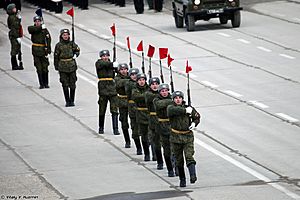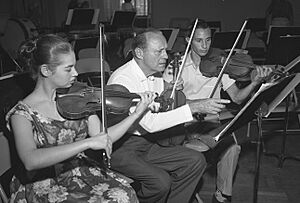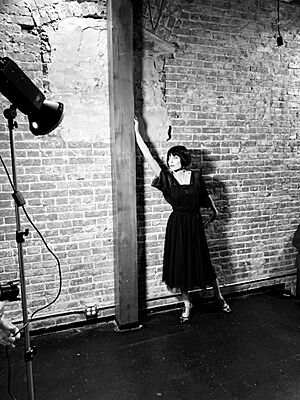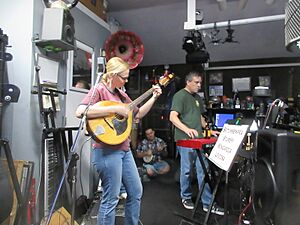Rehearsal facts for kids

A rehearsal is when people practice together for a show or performance. This happens in music, theatre, dance, opera, musical theatre, and film production. Rehearsals help make sure everything is ready and works well for the actual performance.
When one person practices alone, it's usually called practicing. But when a group practices together, like a band or an orchestra, it's called a rehearsal. Music rehearsals often happen in special music rooms.
Rehearsals can be for just a few people, like two actors in a play or a singer with a pianist. They can also be for very large groups, like an orchestra with over 100 musicians or a big choir. Some rehearsals involve only one type of performer, like a singing group without instruments. Others mix different types, such as actors, singers, musicians, and dancers in a musical.
Small groups, like rock bands or jazz groups, might rehearse without a leader. They decide together what to practice. But most medium to large groups have a leader. This person might be a bandleader for a band, a conductor for classical music, or a film director for movies.
Rehearsals are mostly for performing arts. But they can also be used to prepare for other important events. For example, people might rehearse a wedding ceremony. Paramedics might practice responding to a fake emergency. Soldiers might practice an attack using a model of a building.
Contents
Dress Rehearsal: The Final Practice

A dress rehearsal is the last full practice before a performance. Everyone performs as if it were the real show.
For a play, actors wear their costumes. They use all the props and backdrops. They do not use scripts. The stage manager and director might still use them.
For music, musicians do not wear their fancy concert clothes. But they play the whole piece from start to finish. Earlier rehearsals might focus on hard parts. The dress rehearsal is about playing everything smoothly.
Theatre and Opera Rehearsals
In theatre, groups practice a play or show for an audience. Early rehearsals are sometimes called "run-throughs." These usually do not include costumes, lights, or sound. They help actors learn their lines and movements.
A "cue to cue" or "Q-2-Q" is a special practice for the technical crew. This includes lighting and sound people. It helps them practice when to turn on lights, play sound effects, or move things on stage. Actors only say parts of their lines that are cues for the technical team. This helps fix any problems before the show.
Before a Q-2-Q, there might be a "dry tech." This is when technicians practice their cues without the actors.
A "dress rehearsal" is when everyone wears their costumes. The show is performed from start to finish. This includes breaks like intermissions. Sometimes, special guests or reviewers are invited to an "open dress" rehearsal. They might pay less for tickets.
A "preview" is like a rehearsal, but with a full audience who paid for tickets. If there are big problems, the show might stop. Audiences usually pay less for preview tickets.
Music Rehearsals
Professional Music Groups

Professional groups like an orchestra or choir rehearse to play together perfectly. They make sure the rhythm is right and the notes are in tune. They also practice how loud or soft to play.
Professional groups usually have only two or three rehearsals for a piece. They don't play the whole piece every time. Instead, they focus on difficult parts. For example, they might practice a part where different sections play different rhythms.
The conductor leads orchestra rehearsals. They tell the musicians which parts to play. They also explain how they want the music to sound. During early rehearsals, the conductor often stops to give advice. For a choir, a choral conductor leads the rehearsals.
Sometimes, an orchestra has "sectional rehearsals." This is when only one part of the orchestra, like the violins, practices together. Their leader or the conductor helps them.
Before playing with an orchestra, a solo musician practices with a pianist. The pianist plays the orchestra's parts. A metronome might be used to help everyone keep the right speed.
Amateur Music Groups
Amateur groups, like school or community orchestras, also rehearse. They practice for rhythm and tuning, just like pros. But the conductor also teaches them a lot.
Amateur musicians might make more mistakes. The conductor helps them fix these. They also teach players how to blend their sound with others. Rehearsals help amateur groups learn about music history and different playing styles. They also learn new skills, like playing harder rhythms.
Amateur groups usually have many more rehearsals than professional ones. A community orchestra might practice for months for one big piece. A professional orchestra might do it in a few days.
For a show with many different acts, there might be a "walk-through rehearsal" on the show day. Performers walk on and off stage without playing. This helps them remember where to go and what they need. For example, a band needs chairs and music stands. A comedian might want a spotlight.
Pop and Rock Music Rehearsals
Pop, rock, country, and blues bands rehearse before shows. Rehearsals are a place to try out sounds and rhythms. They help bands make their music better.
These rehearsals might be less formal than classical ones. But the goal is the same: to play and sing well together. Early rehearsals often focus on hard parts, like changing tempos or keys. Later rehearsals involve playing whole songs.
The bandleader usually leads pop and rock rehearsals. They are often a member of the band. The bandleader sets the speed for songs. They also choose who takes solos.
The bandleader also picks the rhythm section. These are the instruments that keep the beat and play the chords. This usually includes a piano or guitar, a bass, and drum kits.
Big touring bands with lots of lights and props have many rehearsals for these technical parts. If a pop or rock group plays with an orchestra, a conductor often leads the orchestra.
Rehearsals in Other Areas
Rehearsals are not just for shows. Organizations use them to practice new tasks. Emergency teams often rehearse for disasters. They might even have actors pretend to be injured. This helps workers learn how to help people.
Armies practice attacks on models of buildings. For example, the Israeli Defence Force used a model of an airport to practice the Raid on Entebbe. This helped them free people held hostage on a plane.
Big changes in technology or business are also often rehearsed. This is especially true when many things need to happen at once.
See also
 In Spanish: Ensayo (arte) para niños
In Spanish: Ensayo (arte) para niños
- Sitzprobe
- Stagecraft
- Technical rehearsal



